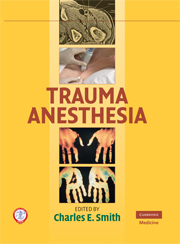Book contents
- Frontmatter
- Contents
- Foreword
- Foreword
- Preface
- Acknowledgments
- Contributors
- 1 Mechanisms and Demographics in Trauma
- 2 Trauma Airway Management
- 3 Shock Management
- 4 Establishing Vascular Access in the Trauma Patient
- 5 Monitoring the Trauma Patient
- 6 Fluid and Blood Therapy in Trauma
- 7 Massive Transfusion Protocols in Trauma Care
- 8 Blood Loss: Does It Change My Intravenous Anesthetic?
- 9 Pharmacology of Neuromuscular Blocking Agents and Their Reversal in Trauma Patients
- 10 Anesthesia Considerations for Abdominal Trauma
- 11 Head Trauma – Anesthesia Considerations and Management
- 12 Intensive Care Unit Management of Pediatric Brain Injury
- 13 Surgical Considerations for Spinal Cord Trauma
- 14 Anesthesia for Spinal Cord Trauma
- 15 Musculoskeletal Trauma
- 16 Anesthetic Considerations for Orthopedic Trauma
- 17 Cardiac and Great Vessel Trauma
- 18 Anesthesia Considerations for Cardiothoracic Trauma
- 19 Intraoperative One-Lung Ventilation for Trauma Anesthesia
- 20 Burn Injuries (Critical Care in Severe Burn Injury)
- 21 Anesthesia for Burns
- 22 Field Anesthesia and Military Injury
- 23 Eye Trauma and Anesthesia
- 24 Pediatric Trauma and Anesthesia
- 25 Trauma in the Elderly
- 26 Trauma in Pregnancy
- 27 Oral and Maxillofacial Trauma
- 28 Damage Control in Severe Trauma
- 29 Hypothermia in Trauma
- 30 ITACCS Management of Mechanical Ventilation in Critically Injured Patients
- 31 Trauma and Regional Anesthesia
- 32 Ultrasound Procedures in Trauma
- 33 Use of Echocardiography and Ultrasound in Trauma
- 34 Pharmacologic Management of Acute Pain in Trauma
- 35 Posttrauma Chronic Pain
- 36 Trauma Systems, Triage, and Transfer
- 37 Teams, Team Training, and the Role of Simulation in Trauma Training and Management
- Index
- Plate section
- References
17 - Cardiac and Great Vessel Trauma
Published online by Cambridge University Press: 18 January 2010
- Frontmatter
- Contents
- Foreword
- Foreword
- Preface
- Acknowledgments
- Contributors
- 1 Mechanisms and Demographics in Trauma
- 2 Trauma Airway Management
- 3 Shock Management
- 4 Establishing Vascular Access in the Trauma Patient
- 5 Monitoring the Trauma Patient
- 6 Fluid and Blood Therapy in Trauma
- 7 Massive Transfusion Protocols in Trauma Care
- 8 Blood Loss: Does It Change My Intravenous Anesthetic?
- 9 Pharmacology of Neuromuscular Blocking Agents and Their Reversal in Trauma Patients
- 10 Anesthesia Considerations for Abdominal Trauma
- 11 Head Trauma – Anesthesia Considerations and Management
- 12 Intensive Care Unit Management of Pediatric Brain Injury
- 13 Surgical Considerations for Spinal Cord Trauma
- 14 Anesthesia for Spinal Cord Trauma
- 15 Musculoskeletal Trauma
- 16 Anesthetic Considerations for Orthopedic Trauma
- 17 Cardiac and Great Vessel Trauma
- 18 Anesthesia Considerations for Cardiothoracic Trauma
- 19 Intraoperative One-Lung Ventilation for Trauma Anesthesia
- 20 Burn Injuries (Critical Care in Severe Burn Injury)
- 21 Anesthesia for Burns
- 22 Field Anesthesia and Military Injury
- 23 Eye Trauma and Anesthesia
- 24 Pediatric Trauma and Anesthesia
- 25 Trauma in the Elderly
- 26 Trauma in Pregnancy
- 27 Oral and Maxillofacial Trauma
- 28 Damage Control in Severe Trauma
- 29 Hypothermia in Trauma
- 30 ITACCS Management of Mechanical Ventilation in Critically Injured Patients
- 31 Trauma and Regional Anesthesia
- 32 Ultrasound Procedures in Trauma
- 33 Use of Echocardiography and Ultrasound in Trauma
- 34 Pharmacologic Management of Acute Pain in Trauma
- 35 Posttrauma Chronic Pain
- 36 Trauma Systems, Triage, and Transfer
- 37 Teams, Team Training, and the Role of Simulation in Trauma Training and Management
- Index
- Plate section
- References
Summary
Objectives
Review the etiologies and consequences of cardiac and great vessel trauma.
Discuss the clinical presentation of cardiac and great vessel trauma.
Evaluate diagnostic strategies for cardiac and great vessel trauma.
Be familiar with decision making and techniques of emergency thoracotomy, a potentially life-saving procedure.
Identify hemorrhage control methods for cardiac and great vessel trauma that an emergency physician should be proficient with until a cardiovascular surgeon arrives.
Discuss the definitive treatment of cardiac and great vessel trauma.
Be familiar with the new applications of endovascular stenting techniques in aortic trauma.
SUMMARY
Blunt and penetrating cardiac and great vessel trauma are associated with potentially life-threatening injuries requiring a high index of suspicion. Cardiac tamponade is often associated with injury to the heart and may quickly lead to hemodynamic compromise, necessitating prompt diagnosis and intervention. The aorta and great vessels are most commonly injured in a blunt manner associated with multisystem trauma, often the result of rapid deceleration. The majority of patients succumb to this type of injury and do not survive to present at hospital. A high index of suspicion for cardiac and aortic injury should be present in any patient involved in trauma to the chest, and appropriate diagnostic measures should be taken once the patient is stabilized.
INTRODUCTION TO CARDIAC TRAUMA
The heart lies in the mediastinum between the two lungs and is enclosed within the pericardium.
- Type
- Chapter
- Information
- Trauma Anesthesia , pp. 260 - 278Publisher: Cambridge University PressPrint publication year: 2008



